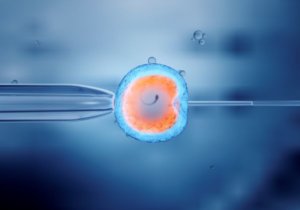The IVF Cycle Deconstructed

If you are considering IVF, or are just curious as to what happens, having a clear understanding of the IVF steps can be helpful. Here is the IVF cycle deconstructed into its five major steps which will help answer questions such as: How do we get the eggs? What happens to the eggs and sperm in the lab? How are the embryos transferred back to the woman? Can the embryos be genetically tested?
It starts with ovarian stimulation
All IVF cycles begin with stimulating the ovaries so that they will produce multiple eggs. Ovarian stimulation medications are given daily as an injection in your abdomen, thigh or upper arm for ten to twelve days. We monitor you along the way with blood tests and ultrasounds to make sure your ovaries are responding nicely.
Mature eggs are retrieved from the ovaries
Egg retrieval is the next step in the IVF cycle and is a surgical procedure performed in our in-office surgical suite. An anesthesia professional will be present during the procedure and will give you an intravenous sedation to make you sleepy.
During the egg retrieval procedure, we place a needle along with an ultrasound probe into your vagina. The needle will be gently moved through the back of your vagina into each mature follicle in your ovaries. Since the retrieval of eggs is done through the vagina, you will not have a cut or incision in your abdomen. The fluid from each follicle-along with the egg-is drawn through the needle.
The egg retrieval procedure usually takes about 20 to 30 minutes, depending on the number of mature follicles you have. After the egg retrieval procedure, we send you to rest in the recovery suite for about an hour. You might experience light vaginal bleeding and lower abdominal discomfort afterwards.
Eggs are fertilized, cultured in the IVF lab, and resulting embryos are either prepared for transfer or frozen
After we retrieve your eggs, they are placed in a special dish in our lab incubator for a minimum of three hours prior to insemination. This brings us to where your guy fits in on this special day. Your male partner will need to produce a sperm specimen for the IVF laboratory to use to fertilize the eggs. Or, if you are using a donor, the sperm will likely already be in our lab and ready to go.
Now it’s time for the magic to happen! This is the point where we bring the eggs and sperm together to create embryos in the IVF lab. In most cases, especially if male factor infertility is involved, we use the ICSI technique (intracytoplasmic sperm injection) to fertilize the eggs. In this procedure, our embryologist will pick up a single sperm under the microscope and inject it directly into the egg to fertilize it.
From here, we give your embryos a few days to divide and grow. After about five days we have a good idea if your embryos are viable and have developed into what we call the blastocyst stage. At this stage, we can decide whether to transfer the best looking embryo to your uterus in what is called a “fresh cycle,” or we may decide to freeze all the embryos to transfer at a later date. More clinicians are choosing the later option to allow the uterus some down-time after being artificially stimulated to produce multiple egg follicles.
If you and your doctor decide frozen is the way to go, a good add-on service at this stage is to genetically test the embryos for chromosomal abnormalities. Chromosomal abnormalities of embryos is the number one reason an IVF cycle fails, so testing embryos using preimplantation genetic testing, PGT-A, can help us choose the embryos most likely to implant. If testing your embryos, we take a few cells from the outer shell of the embryo and send these off to another lab with these testing capabilities. Your embryos are frozen, and when the results come back, we transfer the embryo that contains the normal number of chromosomes.
Transfer day is finally here!
After what we are sure seemed like an eternity for you, it’s finally transfer day where we choose one of your embryos to place in your uterus. During the embryo transfer, your embryo is placed through your cervix into the uterine cavity using a small catheter. This procedure usually requires no anesthesia, although a low dose of valium is occasionally given to help relax the uterus.
Following the embryo transfer, we recommend that you rest in bed for the remainder of the day. Following this, you should avoid strenuous exercise as well as not engage in sexual intercourse until the day of your pregnancy test.
After a two-week wait, you will come in for a pregnancy test
The last step in the IVF cycle is always the hardest. The dreaded “2WW” – or two week wait. We know it will seem like the longest two weeks of your life! This is when Mother Nature takes over and decides whether your embryo will successfully implant or not. During these two weeks, try your best to be patient and find activities to distract your thoughts and reduce your anxiety. Resist the urge to run out to the drugstore to purchase over the counter pregnancy tests.
When you come in for the pregnancy test, we will draw your blood to discover the level of the pregnancy hormone called HCG. We typically can get results back the same day. After two days, we recheck your HCG again to make sure it is rising as expected for a viable pregnancy. Then, after about two weeks you will come back in for an ultrasound where we can get a good picture of the developing fetus in your uterus.
If you are ready to learn more about whether IVF is right for you, contact our Louisiana fertility specialists today to schedule a consult.



